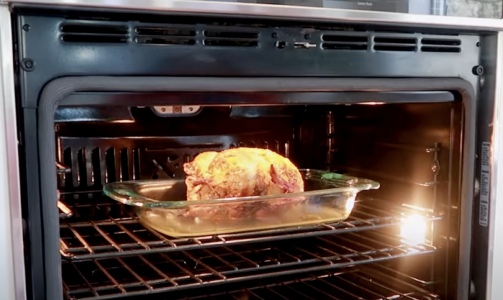The right way to reheat chicken and keep your leftovers safe
By
Veronica E.
- Replies 0
Leftovers are one of life’s small pleasures, especially when last night’s chicken dinner can be enjoyed again the next day.
But reheating poultry isn’t as simple as pressing a button on the microwave.
If it isn’t done correctly, chicken can harbor harmful bacteria that put your health at risk.
For older adults, in particular, foodborne illness is no small matter—it can lead to serious complications.
The good news is that with a few careful steps, you can enjoy your leftovers without worry.

Microwaves heat quickly, but not always evenly.
The US Food and Drug Administration warns that thick foods, like chicken, may come out steaming hot on the outside but remain underheated inside.
Those cooler “pockets” create a breeding ground for bacteria such as salmonella and campylobacter.
Because microwaves work by heating water molecules, they can struggle to fully penetrate dense meats, leaving uneven results that can be unsafe to eat.
Foodborne illnesses aren’t just uncomfortable—they can be dangerous, especially for older adults.
Symptoms like diarrhea, vomiting, fever, and dehydration can be more severe in people with weaker immune systems.
What might be a brief upset for a younger person could mean hospitalization for a senior.
That’s why safe reheating practices are so important.
1. Use the oven
Preheat your oven to 350°F, place chicken in a covered oven-safe dish, and heat until it reaches 165°F internally.
This ensures even heating and keeps meat moist.
2. Try the stovetop
Place chicken in a skillet with a splash of broth or water, cover, and heat gently. Steam helps distribute heat evenly while preventing dryness.
3. Microwave with care
If the microwave is your only option, slice or shred the chicken into smaller, uniform pieces. Spread them in a single layer, cover with a vented lid or damp paper towel, and heat in short intervals.
Stir or flip halfway through, and always check the temperature with a meat thermometer.
4. Let it rest
After reheating, let chicken sit for a couple of minutes. This allows heat to spread evenly and reduces cold spots.
5. Use a thermometer
Always confirm the thickest part of the chicken is at least 165°F. Check more than one spot if reheating large pieces.
With just a little extra care, your favorite chicken dinner can be just as enjoyable the second time around.
By following safe reheating practices and keeping an eye on storage times, you’ll protect your health while still making the most of every meal.
After all, good food should bring comfort, not concern.
Read next: Think it’s safe? This leftover might be more dangerous than you realize

Have you found a reheating trick that keeps chicken juicy and safe? Have you ever had a leftover mishap that made you rethink your method? Share your experiences with The GrayVine community—we’d love to hear your tips.
But reheating poultry isn’t as simple as pressing a button on the microwave.
If it isn’t done correctly, chicken can harbor harmful bacteria that put your health at risk.
For older adults, in particular, foodborne illness is no small matter—it can lead to serious complications.
The good news is that with a few careful steps, you can enjoy your leftovers without worry.

Reheating chicken properly—whether in the oven, on the stove, or with care in the microwave—helps keep every bite safe to eat. Image Source: YouTube /
MOMables - Laura Fuentes.
MOMables - Laura Fuentes.
Why microwaving chicken can be risky
Microwaves heat quickly, but not always evenly.
The US Food and Drug Administration warns that thick foods, like chicken, may come out steaming hot on the outside but remain underheated inside.
Those cooler “pockets” create a breeding ground for bacteria such as salmonella and campylobacter.
Because microwaves work by heating water molecules, they can struggle to fully penetrate dense meats, leaving uneven results that can be unsafe to eat.
Also read: What really happens to Walmart’s leftover cake scraps, according to an employee
The health risks of underheated chicken
Foodborne illnesses aren’t just uncomfortable—they can be dangerous, especially for older adults.
Symptoms like diarrhea, vomiting, fever, and dehydration can be more severe in people with weaker immune systems.
What might be a brief upset for a younger person could mean hospitalization for a senior.
That’s why safe reheating practices are so important.
Also read: 11 everyday kitchen items that help frugal households save big
Safer ways to reheat chicken
1. Use the oven
Preheat your oven to 350°F, place chicken in a covered oven-safe dish, and heat until it reaches 165°F internally.
This ensures even heating and keeps meat moist.
2. Try the stovetop
Place chicken in a skillet with a splash of broth or water, cover, and heat gently. Steam helps distribute heat evenly while preventing dryness.
3. Microwave with care
If the microwave is your only option, slice or shred the chicken into smaller, uniform pieces. Spread them in a single layer, cover with a vented lid or damp paper towel, and heat in short intervals.
Stir or flip halfway through, and always check the temperature with a meat thermometer.
4. Let it rest
After reheating, let chicken sit for a couple of minutes. This allows heat to spread evenly and reduces cold spots.
5. Use a thermometer
Always confirm the thickest part of the chicken is at least 165°F. Check more than one spot if reheating large pieces.
Also read: Stop microwaving these 5 foods immediately–expert warnings you can’t ignore
Extra tips for leftover safety
- Store promptly: Refrigerate leftovers within two hours of cooking, using shallow containers for quicker cooling.
- Reheat only once: Warm up only what you plan to eat. Repeated reheating raises the risk of bacteria growth.
- Watch the clock: Chicken that has been in the fridge more than 3–4 days should be discarded.
- Other foods to watch: Rice, seafood, and eggs also require careful reheating to remain safe.
With just a little extra care, your favorite chicken dinner can be just as enjoyable the second time around.
By following safe reheating practices and keeping an eye on storage times, you’ll protect your health while still making the most of every meal.
After all, good food should bring comfort, not concern.
Read next: Think it’s safe? This leftover might be more dangerous than you realize
Key Takeaways
- Microwaves can heat chicken unevenly, leaving cold spots where bacteria survive.
- Safer reheating methods include using the oven or stovetop, which provide more even heat.
- Adding a bit of liquid and covering food helps prevent dryness and ensures thorough heating.
- Always use a food thermometer to confirm an internal temperature of 165°F before eating.
Have you found a reheating trick that keeps chicken juicy and safe? Have you ever had a leftover mishap that made you rethink your method? Share your experiences with The GrayVine community—we’d love to hear your tips.






